Makereti : Māori ‘Insider’ Anthropology at Oxford
‘No people ever had a better ambassador and interpreter than the Maori had in her’.[i]
According to T.K. Penniman, then Secretary of the Board of Anthropological Studies at Oxford University, and later curator of the Pitt Rivers Museum, Makereti (1872-1930) was the superlative intermediary between Pākehā (New Zealanders of European descent) and Māori (indigenous people of Aotearoa/New Zealand). A fascinating individual, with numerous aliases, Makereti’s life and scholarly pursuits intersected with the early decades of anthropology as a field of study, the University of Oxford, and the British Empire in complex ways.
A bicultural celebrity
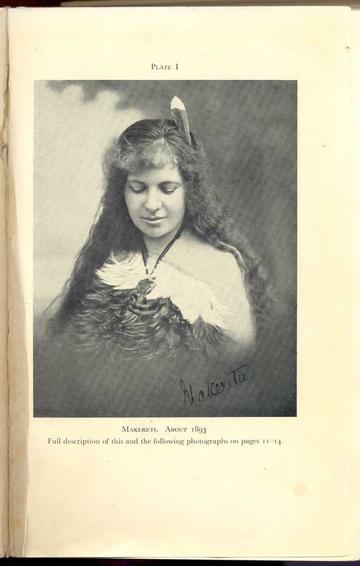
Born Margaret Pattison Thom (1872) to a high-born Māori mother (with Te Arawa/Tuhourangi/Ngāti Wahiao branches) and a Pākehā father, Makereti was raised in a Māori-speaking world for the first nine years of her life. Her elders taught her whakapapa (genealogy), history, and traditional customs that informed her later book, The Old-Time Maori. She then switched to a western education, including three formative years at the renowned Hukarere Māori Girls' College, in Napier. Her fluent English, beauty, and natural charm led to a successful career as a tour guide around the hot springs of Whakarewarewa, a geothermal area in Rotorua, Aotearoa/New Zealand. The apex of her guiding career came in 1901, when she was selected to guide the Duke and Duchess of Cornwall and York, the media coverage of which made her an international celebrity. Featuring prominently in national media, she cultivated her stage persona (‘Maggie Papakura’), becoming widely recognisable by commissioning professional photographic portraits, giving media interviews and writing her own copy for newspapers. In 1905, she published a popular book about the thermal district she knew so intimately, Guide to the Hot Lakes District and Some Maori Legends. Ultimately, she became so famous that international mail addressed to ‘Maggie, New Zealand’ reached her.
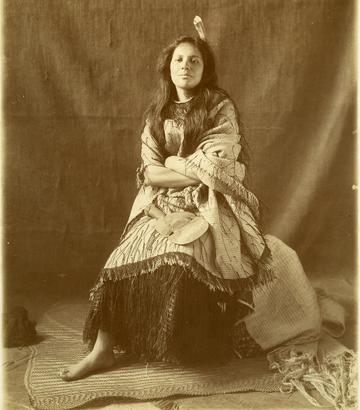
A cultural entrepreneur and charismatic ambassador for her people, Makereti also became something of an impresario. She organised a group of Tuhourangi relatives to travel to America (1906), Australia (1908, 1910), and England (1910-11), performing as a cultural concert party. The English performances were part of the Festival of Empire, which coincided with the coronation of King George V (whom Makereti had met as Duke of Cornwall in 1901). Upon arrival in London, on 28 April 1911, Makereti gave an impromptu press conference at St. Pancras Station. Bursting with patriotism and pro-imperial sentiment on behalf of the entire concert party, she declared that ‘[t]o the Maoris there is no place beyond England, only heaven’. She added that her iwi (kinship group; tribe), Te Arawa, ‘were among the first natives of New Zealand to realize the advantages of British control and the wisdom of submission to a power well and considerably wielded. There were no more loyal subjects of the King than the Arawas and they gave much assistance in quelling of the more unruly branches of the tribe.’[ii] Makereti’s high status inflected her representation of Māori throughout her life, including her scholarship at Oxford. In her personal papers and speeches, Makereti positioned Māori as people of ‘high culture’, distinct from the lower class, ignoble first Europeans they met.[iii] She also juxtaposed Māori against Indigenous Australians,[iv] and—as detailed above—positioned Māori as pro-Empire, and loyal to the British. During this trip, she renewed her acquaintance with Richard Staples-Browne, a wealthy Oxfordshire landowner whom she had guided around Rotorua in 1907. Having accepted his proposal of marriage, she returned to England in 1912 and, as Mrs Staples-Browne, became chatelaine of Oddington Grange, near the village of Islip, Oxfordshire.[v]
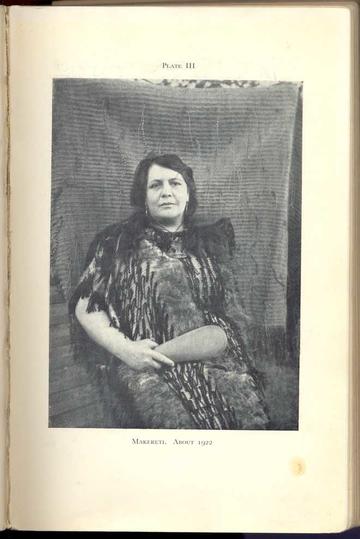
Makereti in Oxford
It is important to situate Makereti within Oxford, a university which—along with Cambridge—formed an integral part of the ‘the apparatus of Britain’s imperial system’, both providing ideological justification for Empire and playing a leading role in general training programmes for the Colonial Office in the interwar period.[vi] Oxford also expanded fields of studies to answer the needs of the British Empire; most of the natural sciences and social sciences faculties are products of the second half of the nineteenth century. Allied with economics and imperial history, anthropology was the discipline most intimately associated with imperialism, and during the 1930s secured a place in what came to be accepted as the ‘science of colonial administration’.[vii] At Oxford in particular, the discipline of anthropology was closely tied to the collection and bequest of General Augustus Pitt Rivers, an officer in the British army, ethnologist, and archaeologist.[viii] Pitt Rivers’ interest in collecting firearms gradually expanded into a collection of comparative technology. In 1883, Pitt Rivers donated this collection of ethnographic and anthropological materials to Oxford, on the condition that it would be housed in its own, separate building, and that someone would be appointed to teach the subject.[ix] Accordingly, Edward Burnett Tylor was appointed as Keeper of the Pitt Rivers Museum in 1883, and Reader in Anthropology in 1884. Robert Ranulph Marett succeeded Tylor as Reader in Anthropology in 1910, having been instrumental in obtaining approval in 1905 for a one-year diploma course in anthropology. This course was justified by ‘the needs for instruction of [Indian Civil Service] probationers and Rhodes Scholars’ at Oxford.[x] In 1909, Marett co-founded the Oxford University Anthropological Society, whose meetings were ‘often concerned with the contribution of anthropology to colonial administration.’[xi] Along with Penniman and Henry Balfour, curator of the Pitt Rivers Museum from 1891 to 1939, Marett was to become one of Makereti’s academic allies and mentors. Makereti’s first recorded interaction with the Museum was in November 1921, when she donated a piupiu (skirt) to its collection.[xii]
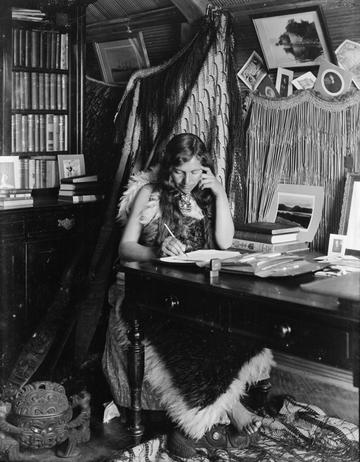
Having retreated almost entirely from the public eye, in 1922, Makereti became an associate member of the Anthropological Society, commencing a significant engagement with the discipline and the university. In 1926, she returned home to Whakarewarewa on a four-month visit and spent much of her time with her kaumātua (elders), describing her intended anthropological project—the study of her own people—and seeking their assistance and blessing. Upon returning to Oxford, she began to collate a life-time’s worth of notes into the first of what she hoped would be a series of books on traditional Māori life.[xiii]
Makereti became a member of the university at the suggestion of Balfour, Marett, and Grace Hadow, Principal of the Oxford Society of Home-Students (now St Anne’s College).[xiv] In January 1927 she was admitted to the Society of Home-Students, registered as a student for the Diploma in Anthropology, and matriculated as ‘Staples-Browne, Margaret Pattison (Mrs)’.[xv] Beyond being only the second Māori to matriculate at Oxford (after her son, Te Aonui Dennan),[xvi] Makereti was also a rarity in being a female student. Between 1900 and 1945, there were few women students at British universities, international or domestic.[xvii]
Moving in academic circles within the nascent discipline of anthropology, Makereti delivered several public lectures on Māori legends, customs and traditions, including addresses to the Women’s Institute, a speech as part of the 1924 British Empire Exhibition, and a 1927 talk on BBC Radio. She also presented a lecture before the Anthropological Society on 8 March 1928.[xviii] For a meeting which usually attracted a modest audience of around 20 members, there were 142 members and visitors in attendance, eager to hear Makereti speak on ‘The Māori as he was’.[xix] She also furnished the largest space in her North Oxford home as the ‘New Zealand Room’. Hung with beautiful korowai (cloaks) of kiwi and kereru feathers and flax, panelled with intricate carvings, and adorned with other Māori artefacts, this room became ‘a marae [meeting place] far away from home.’[xx] Continuing the manaakitanga (hospitality) she had shown convalescent New Zealand soldiers whom she hosted and entertained on the Staples-Browne estates during World War I,[xxi] Makereti held a weekly salon at her home, where budding anthropologists and colonial scholars congregated every Thursday night.[xxii]
The Old-Time Maori
In 1928, Makereti was advised to present a part of her written research for the B.Sc. degree in anthropology.[xxiii] She worked feverishly to complete this thesis on early Māori life. Suffering from muscular rheumatism, and often confined to nursing homes, her illness hampered her mobility and study, but she was assisted throughout by Penniman, an American Rhodes Scholar who became a close friend, mentor, scribe and, ultimately, the protector of her legacy.[xxiv] Their sustained collaboration was remarkable: for the last two years of Makereti's life, Penniman spent a morning or an afternoon three or four times a week at her home in North Oxford, taking notes while they discussed the contents of her thesis. Penniman would ask her what order the notes should take, then took them home and typed them out. Makereti then re-wrote the manuscript multiple times, ‘until she was satisfied that the chapter was a true presentation of the facts and of the spirit. She wrote regularly to her people at home to make certain that they were willing to allow the publication of various facts, or that the facts were exactly right’.[xxv]
Due to present her thesis for examination on 7 May 1930, Makereti died of a heart attack on 15 April 1930. Unfinished at the time of her sudden death, her thesis was published posthumously as The Old-Time Maori in 1938. This was through the efforts of Penniman, who sent the manuscript to Aotearoa/New Zealand for Te Arawa's vetting and approval. Throughout the editing and publication process, he showed complete fidelity to Makereti's instructions and, thus, to those of her iwi. For example, he directed the publishers to delete certain karakia (prayers, chants) on the request of Te Arawa. The text even ends, abruptly, in the middle of a sentence, just as Makereti had handed the manuscript to Penniman.[xxvi]
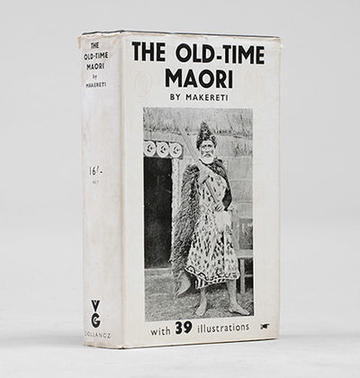
The Old-Time Maori is essentially Makereti’s autobiography, as well as a biography of the ‘old people’ by whom she was raised and to whom the book is dedicated. It narrates the story of the kainga (village) in which she was born, her own early life, and records a lifetime’s observations covering such areas as whakapapa (genealogy); marriages and births; rituals; the collection and cultivation of food; and warfare and weaponry. Through engagement with existing scholarship, this book was intended to correct the misconceptions, ‘outrageous untruths’,[xxvii] and ‘nonsense’[xxviii] of Pākehā anthropologists and ethnographers and thus to amend misperceptions of Māori. Makereti was also writing in the hope that the younger generations of Te Arawa would ‘read and learn how fine a heritage they have, and try to keep what is best in it’.[xxix]
Unique in its collaborative style of writing anthropology—as shown by the iterative drafting and publication process—The Old-Time Maori is also notable for its ‘insider’ perspective. Penniman’s 1938 introduction to The Old-Time Maori notes that Makereti’s lectures, like her book, were invaluable for showing ‘Maori life as it appears to a Maori, rather than to an outsider.’[xxx] Indeed, one of the related benefits of Makereti's anthropology-from-within is that it does not contain the outsider critiques and comparisons that characterized most Pākehā ‘salvage anthropology’.[xxxi] This academic tradition emerged and intensified from the late nineteenth century in Aotearoa/New Zealand. Spurred by the belief that the Māori race was dying out, amateur ethnographers, anthropologists, and historians rushed to record traditional Māori lore, knowledge, and tikanga (customary values and practices). Makereti’s account was also valuable for its deep and respectful engagement with its source community which was, of course, her own community. Respectfully selective in the material collected for publication, Makereti refused to record everything, and instead chose ‘to keep some cultural elements secret’. As distinct from Pākehā anthropologists of that time, she felt ‘no compulsion to make all of Te Arawa culture available to western anthropology’.[xxxii]
Contemporary critical reception
Gender and racial elements were clearly operative in the immediate critical reception of Makereti’s work. While there were positive reviews, some male Pākehā reviewers criticised the text for the reliability of its information, and its ‘insider’ perspective. [xxxiii] The Australian anthropologist, Ralph Piddington, wrote a scathing one-paragraph review in 1940, complaining that ‘Makereti's lack of any conception about what it is important to record about a primitive people, and the personal character of her approach, produce an incoherent and highly idealized picture of Māori life.’[xxxiv] As an early indigenous anthropologist, Makereti bridged the disciplinary gap between ‘native subject/informant’ and ‘anthropological agent’, and was not understood as a scholar capable of analysing the material objectively or correctly.[xxxv]
Legacy
The product of both a lifetime of experience and education, as well as of the academic environment and community of Oxford, The Old-Time Maori is now regarded as an unprecedented work of New Zealand scholarship. The Royal Society of New Zealand Te Apārangi describes its ‘unique place as the first extensive published ethnographic work by a Māori scholar. The most striking quality about the book is that while scholarly in approach, it is based on traditionally acquired knowledge and first-hand experience. Moreover, it reflects the self-awareness of its author who was at all times conscious of her lineage and responsibility to her people.’[xxxvi]
Makereti attempted to ‘reflect the depth of her Māori values and worldview, while at the same time accommodating the rigorous demands of western academic discipline.’[xxxvii] For this reason, her book has been recognised both as prototype for the modern kaupapa Māori research paradigm[xxxviii] and a seminal work of autoethnography.[xxxix] This aligns with Penniman’s biographical note to The Old-Time Maori: ‘her biography is her book, the life-story of her old people … So intimately bound up with her people was she, that she could not write their history without unconsciously writing her own.’[xl] It is unclear, however, how Makereti’s work fits within Linda Tuhiwai Smith’s Decolonizing Metholodogies, which rejects European ways of knowing and representing the past as ongoing cultural colonization.[xli] This is a complex issue, but Makereti exemplifies how Māori protected and (selectively) disseminated mātauranga Māori (Māori knowledge) by co-opting Pākehā knowledge systems, sometimes even by working within the most august academic institutions of the British Empire.[xlii] Indeed, Makereti might have enjoyed a greater academic platform and cultural authority, writing and lecturing as an Oxford student, than writing from elsewhere.
Ultimately, The Old-Time Maori could have been written anywhere. Makereti did not need to be in or affiliated with Oxford to write an account of her people. It was not that Makereti headed to Oxford for its prestige or to acquire knowledge of Māori. She knew her whakapapa and all aspects of te ao Māori (the Māori world) already, and she refreshed this knowledge on her trip home in 1926. What she gained from Oxford and the Pitt Rivers Museum was a disciplinary framework and intellectual and academic mentorship, encouragement, and assistance. Her academic mentors certainly provided bibliographic direction, steering Makereti towards certain texts on Māori which spurred her to correct their errors: to tell the ‘true’ story of traditional Māori life. On a more practical side, for a scholar who was physically unwell for extended periods, Makereti gained the assistance of an amanuensis, in Penniman. Oxford was merely one stage—the final one—in a life devoted to ‘preserving and keeping vigorous all that was best in the old Māori life’.[xliii]
In complex ways, then, Makereti’s engagement with Oxford University and the Pitt Rivers Museum helps us to see indigenous adaptation, interaction, and exchange with institutions often portrayed as incorrigibly ideological sites of imperial hegemony.
Glossary:
iwi (kinship group; tribe)
kainga (village)
karakia (prayers, chants)
kaumātua (elders)
korowai (cloaks)
manaakitanga (hospitality)
Māori (indigenous people of Aotearoa/New Zealand)
marae (meeting place)
mātauranga Māori (Māori knowledge)
Pākehā (New Zealanders of European descent)
piupiu (skirt)
te ao Māori (the Māori world)
tikanga (customary values and practices)
whakapapa (genealogy)
A note on orthography: Macrons indicate a double vowel in te reo Māori (the Māori language). Macrons are used for extended Māori vowels throughout, except in personal names, but have not been added to quotations which predate this practice.
Emma Gattey is an Ertegun Scholar reading for an MSt in Global and Imperial History at Balliol College, Oxford. She is currently researching Māori agency in the production of Pākehā knowledge of Māori, specifically in the disciplines of ethnography, anthropology and linguistics within Oxford and Cambridge.
References:
[i] Makereti, The Old-Time Māori (London, 1938), p. 24.
[ii] P. Diamond, Makereti: Taking Māori to the World (Auckland, 2007), p. 100. Note that Te Arawa was a tribal federation with an early and extensive history of contact with Europeans. Most but not all of Te Arawa fought on the side of the government during the New Zealand Wars of 1845-1872.
[iii] Pitt Rivers Museum Makereti Papers, Box 4.3.5.
[iv] Diamond, Makereti, p. 96.
[v] Makereti, The Old-Time Māori, p. vii.
[vi] S.E. Stockwell, The British End of the British Empire (Cambridge, 2018), p. 23.
[vii] Stockwell, British End of the British Empire, p. 28.
[viii] R. Symonds, Oxford and Empire: The Last Lost Cause? (London, 1991), p. 147.
[ix] Symonds, Oxford and Empire, p. 148.
[x] Symonds, Oxford and Empire, p. 149.
[xi] Symonds, Oxford and Empire, p. 149.
[xii] J. Coote and N. Te Awekotuku, ‘Makereti and the Pitt Rivers Museum, 1921-1930, and Beyond’, in A. Clark, L. Carreau, A. Jelinek, E Lilje and N. Thomas (eds.), Pacific Presences: Oceanic Art and European Museums, Volume 2 (Leiden, 2018), p. 280.
[xiii] Makereti, The Old-Time Māori, p. 24.
[xiv] Makereti, The Old-Time Māori, p. 24.
[xv] Oxford University Gazette, 58/1, 826 (2 February 1927).
[xvi] Dennan later dropped out before completing his diploma: Coote, J., and N. Te Awekotuku, ‘Makereti and the Pitt Rivers Museum’, p. 280.
[xvii] H. Perraton, A History of Foreign Students in Britain (Basingstoke, 2014), p. 55. Women colleges had been in existence since the late 1870s, but were only recognized as colleges of the University of Oxford in 1910. Their students only became full members of the University of Oxford in October 1920, the first time that incoming female students were allowed to matriculate.
[xviii] Makereti, The Old-Time Māori, p. 24; Coote and Te Awekotuku, ‘Makereti and the Pitt Rivers Museum’, p. 283. See also her lecture on Māori legends delivered during ‘Women’s Week’ at Wembley Stadium as part of the British Empire Exhibition of April 1924; and the BBC lecture, ‘Traditions and Customs of the Māori’, delivered on 27 September 1927: Coote and Te Awekotuku, ‘Makereti and the Pitt Rivers Museum’, p. 282.
[xix] Coote and Te Awekotuku, ‘Makereti and the Pitt Rivers Museum’, p. 283.
[xx] Makereti, The Old-Time Māori, p. vii.
[xxi] Charlotte Macdonald, Merimeri Penfold and Bridget Williams, The Book of New Zealand Women: Ko Kui Ma Te Kaupapa (Wellington, 1991), p. 492.
[xxii] Makereti, The Old-Time Māori, p. vii; Macdonald, Penfold and Williams, The Book of New Zealand Women, p. 492.
[xxiii] Makereti, The Old-Time Māori, p. 24.
[xxiv] Diamond, Makereti, pp. 156-157.
[xxv] Makereti, The Old-Time Māori, p. pp. 24-25.
[xxvi] Makereti, The Old-Time Māori, p. 340.
[xxvii] Makereti, The Old-Time Māori, p. ix.
[xxviii] Makereti, The Old-Time Māori, p. 157.
[xxix] Makereti, The Old-Time Māori, p. p. 26.
[xxx] Makereti, The Old-Time Māori, p. 24.
[xxxi] See, for example, H. Beattie, Tikao Talks: Traditions and Tales Told by Teone Taare Tikao to Herries Beattie (Dunedin, 1939), pp. 63-5, 109-110, 124.
[xxxii] M. Treagus, ‘From Whakarewarewa to Oxford: Makereti Papakura and the Politics of Indigenous Self-Representation’, Australian Humanities Review, 52 (2012), p. 52.
[xxxiii] H. E. J. 'The Old-Time Maori. Makereti', Geography, 23/4 (1938), p. 283; E. Ramsden, 'Review of The Old-Time Māori, by Makereti', Mankind 2/6 (1939), p. 191.
[xxxiv] R. Piddington, ‘Review of The Old-Time Māori, by Makereti’, Man 40/5 (1940), p. XX.
[xxxv] Treagus, ‘From Whakarewarewa to Oxford’, p. 51.
[xxxvi] Royal Society Te Apārangi, ‘The Old-Time Māori, by Makereti, Sometimes Chieftainess of the Arawa Tribe, Known in New Zealand as Maggie Papakura (1938)’ <https://www.royalsociety.org.nz/150th-anniversary/tetakarangi/landmarks-bridges-and-visions-aspects-of-maori-culturesidney-moko-mead-2/>. See also Makereti, The Old-Time Māori, p. x.
[xxxvii] Makereti, The Old-Time Māori, p. ix.
[xxxviii] Coote and Te Awekotuku, ‘Makereti and the Pitt Rivers Museum’, pp. 286-287. See http://www.rangahau.co.nz/research-idea/27/ and L.T. Smith, Decolonizing Methodologies: Research and Indigenous Peoples (Dunedin, 1999), pp. 183-195.
[xxxix] Treagus, ‘From Whakarewarewa to Oxford’, p. 52.
[xl] Makereti, The Old-Time Māori, p. 20.
[xli] L.T. Smith, Decolonizing Methodologies: Research and Indigenous Peoples (London, 2013), p. 64.
[xlii] A. Ballara, Iwi: The Dynamics of Maori Tribal Organisation from c.1769 to c.1945 (Wellington, 1998), pp. 21-22. See also P. Gibbons, ‘Cultural Colonization and National Identity’, New Zealand Journal of History, 36/1 (2002), p. 15; J. Belich, Making Peoples: A History of the New Zealanders From Polynesian Settlement to the End of the Nineteenth Century (Auckland, 1996), p. 154.
[xliii] Makereti, The Old-Time Māori, p. 23.


